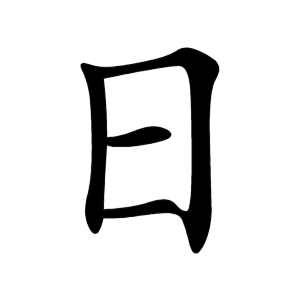日
- day;
- sun;
Etymology
It is a pictogram originally representing the sun. It is one of the most frequently cited examples showing the evolution of Chinese characters from pictograms. Its origin is roughly the shape of a circle with a dot in the middle (⊙). Initially, the sun was depicted exactly as a circle or concentric circles engraved like on a tortoise shell, but as civilization advanced and the number of characters increased, the number of lines in the sun symbol gradually reduced. Eventually, the symbol was abstracted and simplified, changing from a circle to a square.
Another theory says that the middle line is not a dot but represents the horizon, and the outer shape shows the sun’s path over a day.
Similar shape characters
The character 曰 (meaning "to say") looks similar to 日. Originally, 日 (sun) and 曰 (to say) were distinct, but since the clerical script period, their shapes became very similar.
They can be distinguished in two main ways:
1. By aspect ratio — 日 is taller vertically, whereas 曰 is wider horizontally.
2. By whether the middle horizontal stroke touches the enclosing stroke — in 日 it does touch, in 曰 it does not.
However, this depends on the font style and should not be the sole basis for distinction.
Characters with 日
Words that derived from 日
- 금요일(金曜日)–Friday
- 단시일(短時日)–short time
- 목요일(木曜日)–Thursday
- 소일(消日)–idling away; killing time; pastime; diversion
- 수요일(水曜日)–Wednesday
- 안식일(安息日)–Sabbath; Lord´s day
- 요일(曜日)–day of the week
- 월요일(月曜日)–Monday
- 일과표(日課表)–daily schedule
- 일광(日光)–sunlight; sunbeam; sunshine
- 일교차(日較差)–diurnal range; daily range
- 일본(日本)–Japan
- 일본어(日本語)–Japanese
- 일시(日時)–date and time
- 일어(日語)–Japanese
- 일요일(日曜日)–Sunday
- 일정(日程)–program; schedule; itinerary
- 제일(祭日)–day of ancestral rite
- 토요일(土曜日)–Saturday
- 평일(平日)–ordinary times; weekday
- 한일(韓日)–Korean and Japan
- 화요일(火曜日)–Tuesday
- 日 (A)
- ⿴ 囗 一
